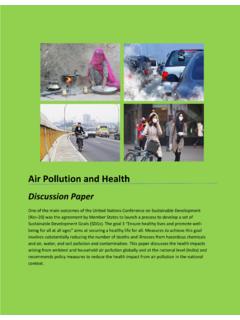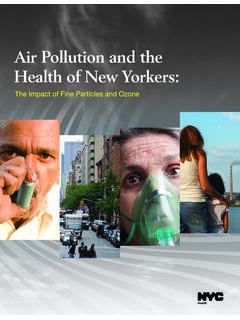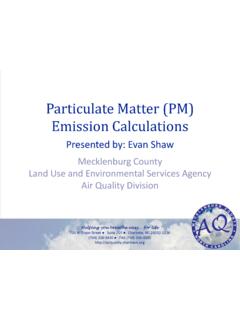Transcription of Section 6 Particulate Matter Controls - US EPA
1 Section 6 Particulate Matter ControlsEPA/452/B-02-001 Chapter 1 Baghouses and FiltersJames H. TurnerResearch Triangle InstituteResearch Triangle Park, NC 22709 John D. McKennaJohn C. MycockArthur B. NunnETS, , VA 24018-4394 William M. VatavukInnovative Strategies and Economics Group, Environmental Protection AgencyResearch Triangle Park, NC 22711 December 1998 EPA/452 Description .. Shaker Cleaning .. Reverse-air Cleaning .. Pulse-jet Cleaning .. Caged Filters .. Cartridge Filters .. Sonic Cleaning .. Auxiliary Equipment .. Fabric Filtration Theory.
2 Reverse Air/Shake Deflate Baghouses .. Pulse-Jet Baghouses .. Design Procedure .. Gas-to-Cloth Ratio .. Gas-to-Cloth Ratio From Similar Applications .. Gas-to-Cloth Ratio From Manufacturer s Methods .. Gas-to-Cloth Ratio From Theoretical/Empirical Equations .. Pressure Drop .. Particle Characteristics .. Gas Stream Characteristics .. Temperature .. Pressure .. Equipment Design Considerations .. Pressure or Suction Housings .. Standard or Custom Construction .. Filter Media .. Estimating Total Capital Investment.
3 Equipment Cost .. Bare Baghouse Costs .. Bag Costs .. Auxiliary Equipment .. Total Purchased Cost .. Total Capital Investment .. Estimating Total Annual Costs .. Direct Annual Cost .. Gas-to-Cloth Ratio From Manufacturer s Methods .. Gas-to-Cloth Ratio From Theoretical/Empirical Equations .. Maintenance .. Replacement Parts .. Electricity .. Fuel .. Water .. Compressed Air .. Dust Disposal .. Annual Cost .. Credits .. Total Annual Cost .. Problem .. fabric filter unit consists of one or more isolated compartments containing rowsof fabric bags in the form of round, flat, or shaped tubes, or pleated cartridges.
4 Particle-laden gas passes up (usually) along the surface of the bags then radially through the are retained on the upstream face of the bags, and the cleaned gas stream is ventedto the atmosphere. The filter is operated cyclically, alternating between relatively longperiods of filtering and short periods of cleaning. During cleaning, dust that has accumulatedon the bags is removed from the fabric surface and deposited in a hopper for filters collect particles with sizes ranging from submicron to several hundredmicrons in diameter at efficiencies generally in excess of 99 or percent.
5 The layer ofdust, or dust cake, collected on the fabric is primarily responsible for such high cake is a barrier with tortuous pores that trap particles as they travel through the temperatures up to about 500EF, with surges to about 550EF can be accommodatedroutinely in some configurations. Most of the energy used to operate the system appears aspressure drop across the bags and associated hardware and ducting. Typical values of systempressure drop range from about 5 to 20 inches of water. Fabric filters are used where high-efficiency particle collection is required.
6 Limitations are imposed by gas characteristics(temperature and corrosivity) and particle characteristics (primarily stickiness) that affectthe fabric or its operation and that cannot be economically process variables include particle characteristics, gas characteristics, andfabric properties. The most important design parameter is the air- or gas-to-cloth ratio (theamount of gas in ft3/min that penetrates one ft2 of fabric) and the usual operating parameterof interest is pressure drop across the filter system. The major operating feature of fabricfilters that distinguishes them from other gas filters is the ability to renew the filteringsurface periodically by cleaning.
7 Common furnace filters, high efficiency Particulate air(HEPA) filters, high efficency air filters (HEAFs), and automotive induction air filters areexamples of filters that must be discarded after a significant layer of dust accumulates onthe surface. These filters are typically made of matted fibers, mounted in supporting frames,and used where dust concentrations are relatively low. Fabric filters are usually made ofwoven or (more commonly) needlepunched felts sewn to the desired shape, mounted in aplenum with special hardware, and used across a wide range of dust type of fabric filter developed in the 1970s and 1980s is the electrostaticallyenhanced filter.
8 Pilot plant baghouses employing this technology have shown substantiallylower pressure drops than conventional filter designs. Further, some cost analyses haveshown that electrostatically enhanced baghouses could have lower lifetime costs thanconvention baghouses. The purpose of this chapter, however, is to focus only on currentlyavailable commercial filters. Readers interested in electrostatically enhanced filtration mayconsult such references as Van Osdell et al. [1] , Viner et al. [2] , or Donovan [3]. DescriptionIn this Section , the types of fabric filters and the auxiliary equipment required arediscussed first from a general viewpoint.
9 Then, fabric filtration theory as applied to eachtype of filter is discussed to lay a foundation for the sizing procedures. Fabric filters can becategorized by several means, including type of cleaning (shaker, reverse-air, pulse-jet),direction of gas flow (from inside the bag towards the outside or vice versa), location of thesystem fan (suction or pressure), or size (low, medium, or high gas flow quantity). Of thesefour approaches, the cleaning method is probably the most distinguishing feature. Fabricfilters are discussed in this Section based on the type of cleaning CleaningFor any type of cleaning, enough energy must be imparted to the fabric to overcomethe adhesion forces holding dust to the bag.
10 In shaker cleaning, used with inside-to-outsidegas flow, energy transfer is accomplished by suspending the bag from a motor-driven hookor framework that oscillates. Motion may be imparted to the bag in several ways, but thegeneral effect is to create a sine wave along the fabric. As the fabric moves outward fromthe bag centerline during portions of the wave action, accumulated dust on the surfacemoves with the fabric. When the fabric reaches the limit of its extension, the patches of dusthave enough inertia to tear away from the fabric and descend to the small, single-compartment baghouses, usually operated intermittently, a leverattached to the shaker mechanism may be operated manually at appropriate intervals, typicallyat the end of a shift.














